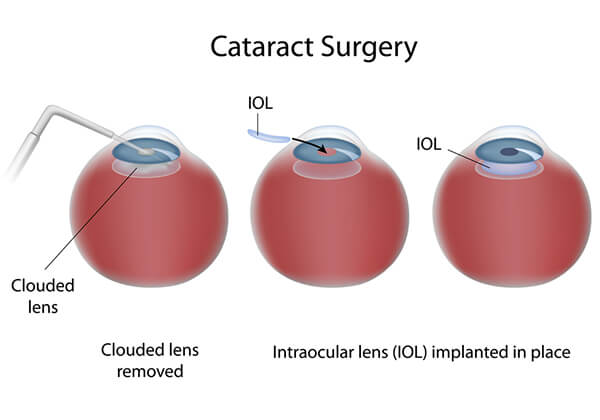How is Cataract Surgery Performed?
Ultrasonic phacoemulsification is the “gold standard” for cataract surgery. In phacoemulsification surgery, a small ultrasonic probe is inserted into a very small incision on the edge of the eye. This probe gently breaks the cloudy lens into tiny pieces and suctions the cataract out of the eye.
The Centurion offers a new method that uses both ultrasound and mechanical oscillation to help break up the cataract faster, and allows the surgeon greater control of lens tissue than traditional ultrasound.
Carroll Vision Center offers no-stitch, small incision cataract surgery to residents of Carroll County and surrounding areas using the new Centurion system. This advanced procedure holds several benefits over conventional forms of cataract surgery. With the no-stitch procedure, patients experience less discomfort, recover more quickly, achieve improved vision more rapidly, and are less likely to incur surgically induced astigmatism than with other forms of cataract surgery.
The Procedure
Our providers begin the procedure by applying a local anesthetic to the eye. There is no injection. A small incision, about 1/6 of an inch wide, is then made in the sclera (the white portion of the eye). The cloudy cataract lens is dissolved using the Alcon Infiniti Phacoemulsificator. After the cataract is removed, a folded intra-ocular lens (IOL) is inserted through the micro-incision, then unfolded and locked into permanent position. The small incision is self-sealing and usually requires no stitches. This type of incision heals quickly and provides a much more comfortable recuperation. The new lens will restore the function of a healthy, natural lens. The entire procedure lasts around 12 minutes, and because of the way the incision is made, the eye can heal without the need for stitches.
Standard Cataract Surgery includes the placement of a standard lens implant to restore brightness, color and clarity to images degraded by slow, progressive cataract formation. This procedure enables you to see distance, but reading glasses or glasses to correct astigmatism will still be required.
Advanced Refractive Cataract Surgery includes special lens implants and refractive technology to restore distance, near and intermediate distance. Designed to mimic the eye’s natural ability to focus on distant, middle and near objects, new lens-implant technologies are used in conjunction with standard cataract extraction methods to help restore a full range of functional vision, from distance to reading vision with total independence from glasses or contact lenses in most cases. Most patients can see to shop, read newspapers and use computers without depending on glasses following surgery. Advanced Refractive Cataract Surgery is an excellent investment in your vision.
We are also pleased to be the first in Carroll County to offer Dropless Cataract Surgery, which helps eliminate the need for drops before and after your procedure. It is a safe and efficient approach, which patients find to be less expensive and more convenient. We will review all of these options with you and determine the best fit for your specific needs when you come in for your evaluation.

After Your Surgery
Because there are no needles or injections, only a tiny incision, stitches and an eye patch are not required after the surgery. In most cases, the incision is so small that the eye heals rapidly, with little or no discomfort, and the patient experiences a quick visual recovery. Patients can typically return to normal activities within a week. The following video describes some symptoms patients may experience directly after their cataract surgery.



